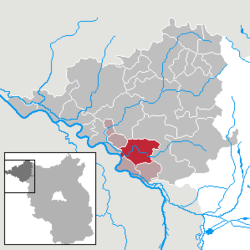Bad Wilsnack
| Bad Wilsnack | ||
|---|---|---|

Town hall and church
|
||
|
||
| Coordinates: 52°57′00″N 11°56′59″E / 52.95000°N 11.94972°ECoordinates: 52°57′00″N 11°56′59″E / 52.95000°N 11.94972°E | ||
| Country | Germany | |
| State | Brandenburg | |
| District | Prignitz | |
| Municipal assoc. | Bad Wilsnack/Weisen | |
| Government | ||
| • Mayor | Dietrich Gappa (CDU) | |
| Area | ||
| • Total | 79.21 km2 (30.58 sq mi) | |
| Elevation | 27 m (89 ft) | |
| Population (2015-12-31) | ||
| • Total | 2,558 | |
| • Density | 32/km2 (84/sq mi) | |
| Time zone | CET/CEST (UTC+1/+2) | |
| Postal codes | 19336 | |
| Dialling codes | 038791 | |
| Vehicle registration | PR | |
| Website | www.bad-wilsnack.de | |
Bad Wilsnack is a small town in the Prignitz district, in Brandenburg, Germany. The former pilgrimage site of the Holy Blood of Wilsnack has been officially recognised as a spa town (Bad) since 1929. It is the administrative seat of the Amt ("municipal federation") Bad Wilsnack/Weisen.
The town is situated within the Prignitz historical region in the northwest of Brandenburg, roughly halfway between Berlin and Hamburg. It is located on the Karthane river, which flows into the Elbe at nearby Wittenberge. A few kilometers to the south is the confluence of the Havel and Elbe rivers. The neighbouring municipality of Rühstädt is famous for its high number of resident white storks.
Bad Wilsnack station is a stop on the Berlin–Hamburg Railway. The townscape is marked by the large St Nicholas Church of the Holy Blood and several timber framed houses.
Wilsnack in the Margraviate of Brandenburg was first mentioned in 1384. The town became a pilgrimage destination after being burned down on 15 August 1383 during a raid by the Mecklenburg captain and robber baron Heinrich von Bülow against the Bishopric of Havelberg. It was believed that aft the fire some hosts were found to have survived, but had the appearance of being bloodied. The Holy Blood of Wilsnack was authenticated when the Havelberg bishop Dietrich Man went to consecrate the hosts as a precaution, and the central one overflowed with blood, according to later accounts. Reformers like Jan Hus and Nicholas of Cusa later discouraged pilgrimage to Wilsnack, questioning the nature of these wonder hosts and suspecting fraud.
...
Wikipedia



